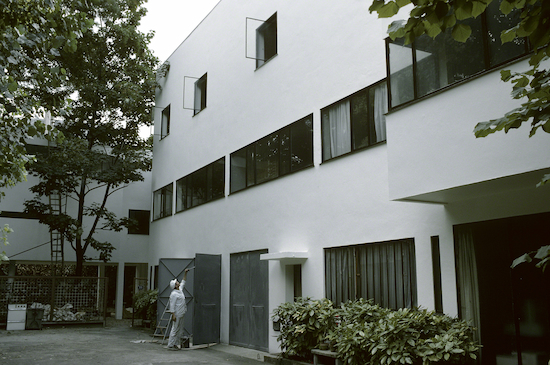Artist Birthday: Le Corbusier
If any one architect’s body of work sums up the development of the International Style, it would be that of Le Corbusier. Le Corbusier filled the world with elegant, geometric and organic, linear buildings that define the idea of “modernism” in architecture.
Artist Birthday for 6 October: Le Corbusier (Charles-Édouard Jeanneret, 1887-1965 Swiss)
This house in Paris displays the elements of the International Style of which Le Corbusier was a pioneer. The steel-reinforced concrete structure has a stucco covering and no decoration. Le Corbusier advocated the use of flat roofs such as this for terraces. The balance of forms and geometricity reflect the influence of classical architecture and the various geometric abstraction movements in painting and sculpture. Le Corbusier pioneered the use of "ribbon windows," which ran horizontally in an uninterrupted line across a facade. Ribbon windows became a common element of the vocabulary of the International Style. They were equally favored, in the US, by pioneer modernist architect Frank Lloyd Wright (1867-1959). Background Although the Art Nouveau style had endeavored to return the arts back to hand-crafting, and a synthesis of fine art and design, it relied on decorative motifs and ideas from past styles, such as Medieval, Islamic, and Renaissance. By the second decade of the 1900s, many architects began to reject the overt decoration of Art Nouveau, and historicism in general that still held sway in architecture. Based on the reductions of form in painting and sculpture to basic geometric shapes, a stripped-down, severely geometric style of architecture evolved. The style endured and was eventually applied to high rise buildings after World War II (1939-1945), spreading from Europe to the rest of the world. The style was known as the International Style. Born in La-Chaux-de-Fonds, Switzerland, Le Corbusier originally studied decoration of watches, then printmaking and goldsmithing, until 1907 when he began to study architecture on his own. He traveled for many years throughout Europe, influenced by many types of regional architecture, including the buildings of ancient Greece and Rome that informed him on classical proportion, and German modernist Peter Behrens whose work educated Le Corbusier on the use of ferro-concrete and the structural impact of the curtain wall (a non-load bearing outer wall typically all glass). Moving to Paris in 1917, he learned of the latest modernism in painting in the Cubist-based style Purism which reduced objects to simple, undetailed geometric shapes. Inspired by Purism, Le Corbusier formulated his mature ideas for architecture based on rejection of non-structural decoration, and on functionalism. It was after discovering Purism that Jeanneret adapted the pseudonym "Le Corbusier" to separate his architectural venture from his painting, revealing it in a journal article in 1920. It is a take off on the name of his maternal grandfather whose name was "Lecorbésier." |
||||||


Comments